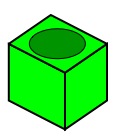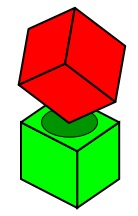Copyright © University of Cambridge. All rights reserved.
'Cubes' printed from https://nrich.maths.org/
Show menu
Why do this problem?
This activity is a good starting point for pupils to learn about surface area of shapes. The further challenge activity provides plenty of real-life opportunities for children to consolidate their fractions knowledge. Completing this task will involve pupils working systematically, using mathematical reasoning to
explain how they know they have found all the possible solutions.
Possible approach
I tend to introduce this activity with a whole class of children sitting around in a circle and the cubes that we are looking at placed in the middle. (I've used 10 cm cubes.) I've asked, "Tell me what you can about this" (one cube placed on the floor). Someone always says that there are six faces or sometimes the word 'side' is used, particularly with younger children. I accept with
interest all the answers that the children give, after all, they are telling me what they know or can see. I focus in on the faces and ask the question set out in the challenge, emphasising that I can place my eyes almost anywhere. This sometimes requires me to lie on the floor!
When everyone is happy with the answer 5, I introduce a second cube and one by one go through the three examples that are set out. I emphasise that the three answers are different. From a teacher's point of view, I ask the children to explain how they are counting. This brings out some very interesting points and you learn a lot about the children.
Moving on to the three cubes I usually do two or three examples and then ask for volunteers to do one for everyone to consider. The fraction examples usually come up and even with young children I find that they are very happy with adding up halves and giving good estimations.
It is probably a good idea not to be particular about the standard of recording in this activity. It is the activity itself in arranging and counting that is important and not artistic skills.
Having left the circle and begun to try their own three-cube arrangements, children get into heated discussions about counting because I ask them to check each other's counting. This difficulty has usually arisen whilst they are in the circle. They share ways of making sure that all are counted and that none are counted twice.
If, as the adult, you need to see in advance what ideas may, and I emphasise may, come from the pupils then click here.
If, as the adult, you need to see in advance what ideas may, and I emphasise may, come from the pupils then click here.

Key questions
Tell me about the parts that you can see.
Tell me about this bit here that is not a whole face.
Possible extension
You can give pupils the opportunity to categorise the shapes that they make and the sizes of areas they find. You could also move on to using more cubes.
For more extension work
When working with a very high-attaining pupil I used the idea of a cube with a circular hole. There happened to be an old powder paint container around that gave me the idea. So, imagine (or use if you've got one) a cube that has a circular hole in the top. The hole is covered in a special paper - so that a "vertex down" cube can pierce the paper as it is lowered into the hole. The remaining
paper stays intact! Or you could think of it as the green cube being filled with sand, the red cube is pushed in and overspill-sand is wiped away.
What is the total area of the green and the red cubes' surfaces that are now visible?
This picture gives some idea of how the red cube is as it is about to be lowered into the cylindrical hole.


Possible support
Some pupils will find it helpful to be able to keep their finished arrangements, instead of breaking them up. This will allow children to focus on building the arrangements and working out the totals rather than getting held up with drawing or recording their solutions. Taking photographs of the arrangements is another option for these pupils.


